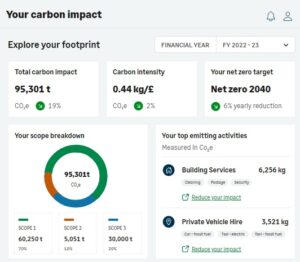Sustainability goes mainstream when it hits Main Street. Advanced by the creators of Sage Earth, a new carbon accounting solution targeted at small and medium sized businesses, the weight of this proposition is difficult to dispute. With the climate emergency gathering gale force, and governments across the globe falling short on commitments to meet the long-term goals of the Paris Agreement, it is time for all state and non-state actors to do their part to keep global temperatures to a level that can preserve life. In Canada, outreach to the SMB community is especially important: in 2023, approximately 98% of businesses were defined as small, close to 2% were medium sized, and together these accounted for roughly half of the country’s GDP.


But inspiring this segment to embark on a path that allows them to demonstrate sustainability practice has proved challenging. Data collected in a recent report authored by Sage, PwC UK, Strand Partners, and the International Chamber of Commerce notes a significant gap between SBM intentions and their ability to demonstrate progress on sustainability. While 6 in 10 SMBs globally state they are taking action on sustainability, 67% of Canadian SMBs see sustainability as important to their businesses and have environmental, social, or sustainability-related policies on how they conduct business activities. According to Elisa Moscolin, EVP of Sustainability and Foundation at the Sage Group, even though there isn’t as much regulation in Canada as in other jurisdictions, Canadian businesses rank on par with Belgium, France, Germany in terms of their views of the importance of reporting on sustainability, and on the value of reporting standards. But despite this strong statement of value, only 7.7% of the global SMB total are engaged in reporting on sustainability activities. Lack of time, budget, and specialized skills within SMB organizations have combined with complexity in reporting frameworks, and data collection/analysis issues to discourage reporting, a critical first step in monitoring and managing sustainability performance – and the prelude to accelerating action.
The carrot and the stick
How is it possible to square this circle? In motivating small and medium sized businesses to bridge this gap, the carrot and the stick are proving useful. On the stick side of the equation, many businesses are facing increased regulation. The CSRD and the proposed supply-chain focused CSDDD in the EU, and new SEC financial requirements introduced in the US this year for audited reporting when organizations claim progress on sustainability, are just two examples of regulation that is impacting businesses within specific jurisdictions as well commercial partners beyond their borders – and which are setting examples for other counties to follow. These regulations typically mandate reporting for larger corporations (environmental caps in Canada typically target the large, heavy emitters of carbon and other pollution). At the same time, SMBs appear upstream and downsteam within a particular corporate, product, or industry ecosystem, and hence can be required by customers and or as suppliers to provide environmental data that may be rolled up into partner reporting.

The potential for driving environmental performance through supply chain is significant; a UK consultancy, Carbon Trust, has calculated that up to 90% of an organization’s environmental impact (in the product use phase) lies in its value chain. Depending on the industry (and other calculations), this impact may be lower. But as George Sandilands, VP of Carbon Accounting for Sage Earth, noted, one of the biggest challenges on the journey to net zero, especially for large enterprises, is that they have value chains, full of smaller businesses that are really struggling to report: “In the UK [current Sage Earth release], the pressure to begin a carbon reduction journey comes from supply chain. Large enterprises that you may trade with are asking partners to share impact information. Any large enterprise with science-based targets, Sage included, is trying to figure out how that information is going to be collected at scale, with data that they can make decisions on – primarily Scope 3 data.”
To support these potential SMB users, Sage Earth is targeting the creation of commercial partnerships with large enterprises to help them with Scope 3 reporting needs. For example, Sage Earth underpins a product called Carbon Planner for one of the company’s largest UK banking customers. Using the Sage Earth maps and methodologies, the bank helps SMB customers demonstrate climate action that can change their risk matrix and then rewards them for it; any business that can show demonstrate progress using the platform will get access to a lower interest rate, a credit benefit that will materially affect SMBs. In Sandilands’ view, linking improved credit to climate action at scale has huge potential – it acts as an incentive that can may help drive better sustainability reporting for the bank, better performance for the SMB customer, and better protection for the planet.
While banks or other large enterprises may serve as a sophisticated distribution channel, Sage Earth software has also enabled links into existing Sage products, and with other accounting solutions such as QuickBooks, or Xero, or Free Agent – and the Sage Earth team has other connectors on its roadmap. The goal of this open approach, according to Moscolin, is to drive adoption as broadly and as quickly as possible: “this goes back to the second pillar in our sustainability strategy, which is to knock down barriers for SMBs. In pursuit of that, we need to give up a bit of ego – to enable as many SMBs as possible to embark on this journey. We are taking a collaborative approach. This is a complex puzzle, and we hold only one piece – we need to mobilize the whole ecosystem.”
Based on open protocols to support different types of data and platforms and shared understandings, this collaboration includes work with connectors, enterprise channels, strategic partners, such as AWS, which provides infrastructure and AI services and is now working with Sage to develop a network of large enterprises that may adopt the solution as a standard in their respective SMB ecosystems, with organizations such as the Carbon Accounting Alliance, which launched only recently but has approximately 400 member companies, and on demonstration projects such as Perseus, a UK trust framework that automates the flow of real time Scope 2 electricity data, and which brought together utilities, government, legal frameworks, and carbon accounting providers for a common view on reporting.
In Moscolin’s view, SMB engagement will depend on a variety of factors, including establishment of the right regulatory environment, the right policies, the right standards and reporting frameworks, education, and knowledge. An additional ‘carrot’ is knowledge of how to build a “reconstructed” business case for sustainability that takes into account financial metrics, but also a new evaluation of risk and reward, climate impacts, carbon taxes and markets, social license to operate, and also the need for collaboration within competition – factors that can have an effect on the longer-term viability of the business.[1] According to Moscolin, “this is not just the right thing to do; it’s the smart thing to do… For SMBs that are constantly putting out fires [and more vulnerable to climate events], and juggling multiple priorities, the ability to measure impact and reduce carbon emissions will contribute to resilience, to SMB viability.”
More and less data
Another key enabler is technology – in this case, Sage Earth. Designed to address primary obstacles SMBs face as they look to introduce, or improve sustainability reporting, Sage Earth software provides automation, data management, and AI capabilities to enhance the quality of carbon reporting, and a simplified interface to ease the reporting burden.
Data is a critical challenge for many organizations, and the SMB in particular, which may have resources for core business, but fewer for data management or analysis. Depending on the operation, the industry, and the supply chain, data may be collected in multiple formats – while its alignment with different reporting structures remains obscure. To address issues with multiple data inputs, Sage Earth has worked with the AWS sustainability team to create a Sustainability Data Fabric, the technical infrastructure needed to post and clean up and manage multiple data flows. The Sage Earth role is to ease data submission – to ensure that data is going to the right place for each GHG scope. Through a Q&A based system, the software develops context for the data point, constantly improving its ability to line up data flows across various scopes. AI is used to match data inputs with available EIFs (Emissions Intensity Factors – published academic sources that identify impact); large language models categorize data to align with a hierarchical taxonomy of carbon impacts. The product is designed against twenty scopes of the GHG Protocol, automating classification and alignment to alleviate a good share of the reporting requirement, as it improves accuracy. For future, the team is looking to Generative AI to develop a “talk to your data” piece, a chatbot powered by BI tooling that will provide users with more insight into their own data.
In some cases, the issue is less data, rather than more. In Sandilands’ view, direct data input from the user is likely to improve the nature of the emissions calculations that are achieved, and so the software works by first looking through financial data (receipts) to create an automated response in each reporting area. When this is not available, Sage Earth will look to secondary data to create benchmarks or proxies, based on data collected by the broad ecosystem of 120,000 existing Sage customers who have benchmarked against CDP reporting, as well as AWS sale data and government data feeds. Data can be segmented by company size or industry; the goal is to provide broad perspective, and as Sandilands noted, to “try to improve by including primary, activity data and linking this to existing data feeds, financial data feeds as the backbone,” incorporating equivalents and open data in various reporting mechanisms to enhance compliance.
Ease of use

By aligning with all the various standards in a very modular product that supports input of data in multiple formats, and the export of data in a way that allows users to do SBTI (or other) reporting, Sage Earth aims to make the reporting process simple and easy for users, while providing quality real world data, which can be trusted as it originates in financial accounting. The front-end view is simplified – the user interface presents familiar items such as water usage, fuel consumption, or vehicles, which on the backend are broken down into various categories of the GHG Protocol. The driving principle is to initiate the SBM user, and introduce them to the platform even if data is not 100% accurate from day one – with the understanding that data will improve over time, inspiring greater trust in reporting for the organization and its partners.
Prospects
Today Sage Earth is live only in UK, but the solution is scaling out to other territories in FY 25. Primary targets are existing Sage customers who may be at an early stage in adoption, but the company hopes to accelerate adoption via partnerships with customers like the NatWest bank in the UK, who have brought 7,000 users on board (described above). Sage Earth is now engaged in building relationship with an Australian and a Canadian bank – accessing SMBs through these or other enterprise networks is their main strategy for driving adoption. The more SMBs that are on board, the more data that will be brought into the system – virality will improve the experience for all, is the thinking. Currently, the solution is focused on measurement, but Sage Earth is working towards mitigation functionality, or helping SMBs identify specific actions they can take to more quickly decarbonize. This is where the magic will happen.
[1] See, for example, discussion in “Reconstructing the Business Case for Data Center Sustainability,” Greener Data, v. 2: Actionable Insights From Industry Experts. April 2024. https://www.amazon.com/dp/B0D21X3GCN








